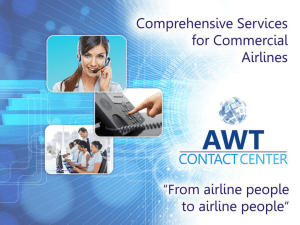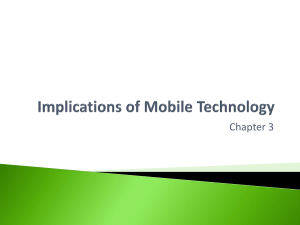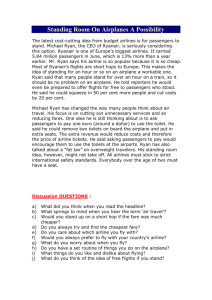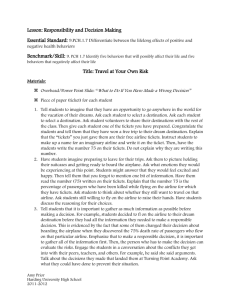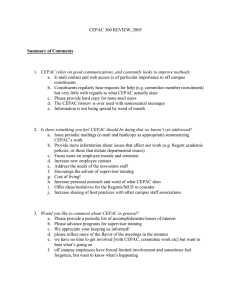4. Details on the Airline Business
advertisement
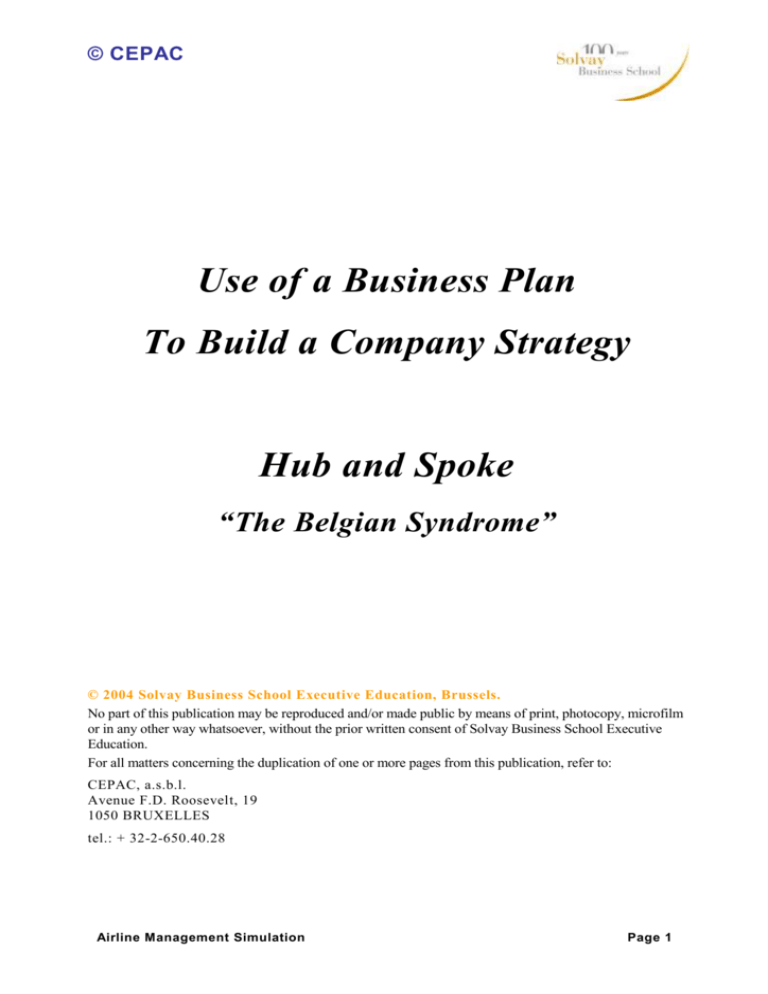
© CEPAC Use of a Business Plan To Build a Company Strategy Hub and Spoke “The Belgian Syndrome” © 2004 Solvay Business School Executive Education, Brussels. No part of this publication may be reproduced and/or made public by means of print, photocopy, microfilm or in any other way whatsoever, without the prior written consent of Solvay Business School Executive Education. For all matters concerning the duplication of one or more pages from this publication, refer to: CEPAC, a.s.b.l. Avenue F.D. Roosevelt, 19 1050 BRUXELLES tel.: + 32-2-650.40.28 Airline Management Simulation Page 1 © CEPAC TABLE OF CONTENTS 1. INTRODUCTION 3 2. THE AIRLINE INDUSTRY ENVIRONMENT 4 General Overview Regulation 3. GENERAL PRINCIPLES FOR THE GAME Team Arrangement Decision periods Game Management Assessment Rankings 4. DETAILS ON AIRLINE BUSINESS Network Fleet Products & Fares Distribution Channels Organisation Personnel Market information 5. FINANCES P&L Account Cash Flow Statement Balance Sheet Financial Ratios Financing the activity 6. FINAL VALUATION Airline Management Game 4 4 5 5 5 6 6 7 8 9 10 13 14 15 15 17 18 18 18 18 19 19 20 Page 2 © CEPAC 1 . Introduction The Business plan is a splendid simulation tool to assess a company strategy. You and your fellow team members take on the roles of the management team of a company in the airline industry. The company operates an airline based in the capital of a medium size European country and has to determine its strategy for the 10 coming years. The simulation period begins in 1998. Just before that first year, the company has to take a major decision regarding the replacement and development of its medium-haul fleet. Indeed, on November 17, 1997, the Board of Directors will take a decision based on the recommendation of your team to renew and if necessary expand the company’s fleet. An appropriate recommendation for this decision will be your first challenge. The Business Plan tool you will use is built on a year basis starting in 1998. You’ll go through a number of the decision-forming processes that are similar with those that face management in the “real world”. In this way the simulation enhances insight into corporate processes and trains participants to deal with and interpret operating, financial and other company data. Competitive aspects play an important role in the Business Plan exercise as the model simulates the impact of your commercial decisions in terms of market share, load factor, etc This document contains all the publicly known information on the industry and general recommendations on the work to be done. Airline Management Simulation Page 3 © CEPAC 2 . The Airline industry environment General overview We are in fall 1997. Together with your fellow team members you have just been appointed as the management of a European company, which operates and wants to develop an airline business. Airline transport is a quite booming industry with an expected yearly growth rate of 6 % for the 5 coming years. But airline transport is also a difficult industry, particularly for old European companies with heavy management structures, unionised personnel, and poor flexibility. It is especially the case for the company you have to manage. After having been for more than 60 years a state owned company, it experienced two unsuccessful attempts to merge with top European airlines. Finally an agreement was signed in 1995 giving a smaller but highly rewarded airline 49,5 % of the shares of the company. This new shareholder wants to develop a growth strategy for your company in its group but despite being named “the Flying Bank”, it has made very clear that it did not intend to put very much additional capital in the business. The company operates an hub to and from its base airport, Brüsel. The hub gives the possibility to operate more lines with more efficient aeroplanes, both in Europe and intercontinental, as additional traffic is generated by transfer passengers flying between their origin and destination via a connection in your base. Nevertheless these passengers do not generate high margins as, for one single journey, they use two flights and as on the journeys they make you are often in competition with other carriers offering direct flights. The hub model is also very demanding from organisation and operation viewpoints as the system must offer rapid and reliable connections. Airline Management Game Page 4 © CEPAC 3. General Principles for the Business Plan Team arrangement As a rule, a management team should comprise a maximum of 6 persons (if there are more than 6 persons deputy roles can be devoted). Before starting the simulation we strongly advise that you take some time to contemplate the structure and organisation of your team. For every area in which you will be required to make decisions, you can identify tasks. In this context you could appoint at least : 1°) a General Manager ; 2°) a Network Manager ; 3°) a Commercial Manager ; 4°) a Human Ressources Manager ; 5°) a Financial Manager. Experience has shown that it can be more efficient if you delegate responsibilities within your team. All important decisions should of course be made jointly. If your team comprises less than 5 members, some of the members can combine two functions. As a management team you will have to take into account the interests of all the stakeholders : internal parties (such as your personnel and shareholders) as well as external parties (such as your suppliers, bankers, competitors and customers). The demands of these stakeholders can sometimes be diametrically opposite to one another. For example, your personnel will probably want to have stable working times while customers on the other hand like to have flights at the most convenient moments of the year, of the week and of the day. You will have to bear the interests of all these parties in mind while making your decisions so that your company does not suffer as a consequence. Therefore, in order to keep all stakeholders satisfied, the management must find suitable compromises. The most effective solution is to formulate a number of goals or objectives to try to achieve and to anticipate the contradictions between these different goals and objectives. By doing so you will be forcing yourself to actively contemplate the future of your company and this will give you a mental picture of the most important factors which are likely to influence the future. Decision periods For the Business Plan, the period will be the year and the simulations will start in 1998 up to 2007 (10 years). There are time delays of one year between the moment when you make some decisions and the moment when its has effects. For instance the efforts to improve quality have only full impact after one year. Airline Management Game Page 5 © CEPAC Decisions The During each period, your team will make decisions that affect the present and the following years. Each period you will have to fill in your decisions in the decision form. You will have to fill only the blank frames in the INP Sheet. There will be a partial check of the input done by the computer but some input can have very negative consequences on the model (f.i. text input instead of figures !). If this happen simply close the Excel Worksheet (without Save) and open it again. Results For each Simulation based on assumptions made by the team for the 10-year period , you will receive the results of your decisions for each year in the FIN Sheet (operations, activity for each route, commercial results, financial statements). You will have to look carefully to the results of your decisions. By studying these results and comparing them with your strategic goals, you will decide what is best to try to improve your position. The consequences of a particular decision cannot be accurately predicted in advance. Just as is the case in reality, your company situation will also depend on the reactions of the market simulated by the model. Simulation Coach The Simulation Coach (professor and assistant professor or a person appointed to the function) will act as a facilitator. In other words it will not so much be the responsibility of the Simulation Coach to teach you, but more to stimulate the learning process on your part. The Simulation Coach will therefore, when necessary, explain the rules and the procedures of the Simulation. Assessment Criteria In order to be as close as possible to the real world, it is useful to look carefully to all the aspects of your performance. So look carefully to all the results in the FIN Sheet (not only the financial statements but also the operation indicators). You can assess your performance on the base of the following components : 1°) The Financial indicators (EBITDA, Earning after Taxes, Equity, Total Debt, Financial ratios); 2°) The Personnel Performance (Total number, Productivity (ASK/personnel/year), Morale Level, Yearly turn-over) ; 3°) The Fleet Performance (Number of planes, Service-hours per day, Productivity, Average age of the fleet, Punctuality, Quality) ; 4°) The Production Performance (Total volume, Passenger per flight, Average distance, Cost per Available-Seat-Kilometer, Load Factor) ; Airline Management Game Page 6 © CEPAC 5°) The Revenue Performance (Total income, Business share (as a number of passengers), Transfer share (as a number of passengers), Market share at Brüsel, Yield) 6°) The Value Creation (see section 6). Airline Management Game Page 7 © CEPAC Some comments on these indicators : Overall Quality Level The overall quality level is directly related to the customer satisfaction. As it is an indication of what your customers think of your service. The index runs from 1 (very bad) to 10 (very good). It is directly related to the punctuality (the higher the better), the quality of on-board service and the average age of the fleet (the newer the better). Personnel morale Your personnel morale is certainly not the least important factor that can have a bearing on your performance. The morale of your personnel has a direct impact on the productivity and on the quality of service within your company. It is also very important if you want to keep your personnel in the future by reducing its turn-over, as the airline business is a very competitive market with a limited number of skilled persons. The morale index runs from 1 (very low morale) to 10 (very high morale). It is directly related to the level of the wages compared to the wages paid by competitors, and to the productivity requirements of the company (the higher the productivity, the lower the personnel morale). Continuity You must do all what you can to leave your company in such condition that it will have every chance of survival in the future. You should absolutely avoid an unrealistic 'end-play’ in the final periods (as stopping to invest), as this will have a negative effect on your final valuation. 4. Details on the Airline Business Airline transport is a complex business from the market view point and from the operations point of view. People use air transport for business and for leisure purposes. For the business travellers’ time is important. It does mean that that these travellers are ready to pay quite high prices in the measure where they have frequent flights on the routes they use. Their decision to travel with your airline will also depend on the fact that you offer services on many routes and on the quality of the onboard service (food, etc.). For the leisure travellers’ price is important. It does mean that they want to pay the lowest possible fare and that they only marginally care on the frequency of the flights and on the onboard service. You will have to design your network taking into account the market on each route but also the competition and the best use of your fleet. At the beginning of the Business Plan the situation of the fleet is quite odd. Both the long haul and medium-short haul fleets are old (13 medium haul B737 are 25 years old !). Decisions to Airline Management Game Page 8 © CEPAC renew and expand the long haul fleet was taken 2 years ago and will be completed in 2002. The short haul fleet has been recently renewed. The fleet can be adjusted by buying new aircrafts to manufacturers and selling older aircrafts. The first decision you will have to take in November 1997 relates to a projected important order of new medium haul planes that has been submitted to the Board of Directors. The proposal made until now to the Board of Directors is to replace rapidly all the Boeing B737 fleet by new Airbus A320 planes. You will have to make a final proposal regarding this decision. Do not forget that the fleet need to be adjusted to your activity : if you have too many aircrafts compared to your traffic either the planes will remain unused, or they will fly but will be quite empty or you will have to reduce the unit income dramatically to fill them with passengers. Your personnel will also be adjusted to the traffic to provide a good service to the customers (more people) with a good productivity (less people). The number of personnel will be calculated automatically by the model depending on your decisions on the activity and on the work-hours of the pilots and cabin crew. Network You will have to establish an optimal hub-and-spoke network. From your hub you will operate to the 4 other major hubs in Europe and you will possibly operate to 10 long haul destinations and to 20 other European destinations. Routes operated In 1997 you operate to the 4 other hubs, 9 long-haul routes from your base airport and 18 other European routes You can decide to operate new routes and to close some routes. This decision can be taken for each year. When you operates to an airport you will incur the cost of a station at this airport. This is a fixed cost for a station plus variable costs related to the number of flights to this airport and variable costs related to the number of passengers to this airport. This cost will be automatically calculated by the model (see further). Service on operated Routes For each operated route you will have to decide for each year the number of weekly (return) flights and the type of aircrafts you will use. If you use small aircrafts you will be able to have more flights for the same traffic but the unit cost per available-seat-kilometre (ASK) will be high. If you use large aircraft the unit cost per ASK will be lower but you will be able to offer less weekly flights. Airline Management Game Page 9 © CEPAC Fleet Existing fleet At the beginning of the simulation, in 1997, you have in total 60 planes with the following characteristics: Aircraft type Number Average age Number of seats per plane 272 Historical unit acquisition cost (Mio€) 80-125 9 5,8 years B737 (medium haul) 28 15,8 years 104 40 AVRO (Regional jet) 23 0,7 years 86 25 long-haul (most are Airbus A330 – A340 except 2 B747 21 years old) It is important to notice that of your 28 B737, you will have to replace 10 before the end of 2000 because they will not respect the noise regulations any more. 6 Additional AVRO’s will be delivered in 1998 and 1 new Airbus A330 each year in 1998, 1999 and 2000. Obviously, these acquisitions will have an impact on your cash flow. Aircraft acquisitions You have the possibility to acquire new planes with the following characteristics : Aircraft type A330 (long-haul)1 Number of seats 272 Catalogue price (Mio€) 125 Maintenance Maintenance fixed cost variable cost (€ per month) (€ per hour) 175.000 600 Fuel use (gallon / hour) 2.150 B737 (medium haul) 120-180 35-452 40.500 185 6453 A320 (medium haul) 120-180 35-454 39.000 175 625 AVRO (Regional jet) 22-274 28.000 115 415 60-90 If you decide to buy Airbus A320 you will have an important initial training cost for the pilots (32,5 Millions € in total in the first three years of operations if you buy 30 new planes4) and you will have to buy spare parts for 100 Millions € in total in the the first three years of operations but these planes use less fuel (625 gallon / hour instead of 645 gallon/hour) than new B737 and 1 2 3 4 Or B777 if you choose the Boeing Family Depending on the number of seats per aircraft 683 gallon/hour for the old Boeing B737 There will also be a training cost if you buy a large number of new B737 but the cost will be reduced by 50% compared to A320. Airline Management Game Page 10 © CEPAC as your fleet will be unified you will make a permanent saving in training equivalent to 2% of the pilot salary cost. If you decide to buy new B737, Boeing is ready to buy for cash 30% of your Technics Department for 50 Millions €. For you new order, you will have to decide the average size of your medium haul (B737 or A320) and regional jets (AVRO). The average number of seats can vary between 120 and 180 for the medium haul, with a catalogue price of 35 Millions € for the 120 seaters and of 45 Millions € for the 180 seaters (for instance : if you decide for 150 seats in average, the catalogue price will be 40 Mio€ per aircraft). For the AVRO, you can choose the average number of seats between 60 and 90 with a catalogue price varying from 22 Millions € to 27 Millions €. The benefits to make an initial large order are numerous : The catalogue price will be guaranteed ; There will be a discount related to the order size. If the catalogue price of the order is equal to 500 Millions € the discount will be 5 % with an additional 1 % discount for any additional 100 Millions €. There is an additional discount depending on the timing of the deliveries. If the average delivering time is lower than 3 years an additional discount of 4% will be offered. This additional discount will amount to 2% if the average delivery time is lower than 4 years but there will be no additional discount if the average delivery time is higher than 4 years ; The sale price of the existing B737 will be guaranteed until 2002 ; The discount will also be applied to further orders and to the delivery of the 6 AVRO and 3 A330 already ordered. The acquisition cost (capital expenditure) will be depreciated on the base of 10,0% of the purchase price per year (complete depreciation after 10 years). Each aircraft can be operated up to 18 service-hours a day but you can have punctuality problems if you use them in average more than 14 hours a day for the short-medium haul and more than 16 hours a day for the long-haul. For each rotation (return flight between two airports) you have to count the block-time5 (twice the time of a one-way flight) plus twice the time necessary to unload and load the passenger at the airports. For instance the time necessary to operate a Brüsel-Athens rotation with an B737 is 7,5 hours (twice 3 hours plus twice 45 minutes). The more you use the plane the lower the average fixed cost per flight-hour and the lower the cost per available-seatkilometre (ASK). But you have to take care that if you use you plane very much the spare time between two rotations will be short and if any problem occurs you will suffer delayed flights and the overall quality of your service will deteriorate. The average age of your fleet compared to the competitors will be an important, competitive factor as with a younger fleet the overall quality of service will be better and the maintenance cost will be lower. 5 Block-time is the time elapsed between the moment where the plane leaves its block at the departing airport and the moment where it reaches its blocks at the arriving airport Airline Management Game Page 11 © CEPAC On each Route you will operate with one type of aircraft. It does mean that you have to choose on each Route the type most appropriated to the traffic volume. Selling planes You can sell existing planes at any time. The sale price will be equal to the acquisition price less 5% per year (with a minimum of 25%) of the acquisition price. A premium or a discount will be applied depending on the market situation. Personnel & Service You can also improve or reduce the service onboard by changing the number of stewards. Fleet strategy In order facilitate your strategic decision on the fleet, four typical strategies can be described. “HUNTER” You replace all your B737 by new planes of the A320 family. In order to develop your business you buy also additional planes (total order 34 planes). The new planes are delivered between 1998 and 2003. On top of that you buy 4 additional A330 delivered in 2001 and 2003. “AMBITIOUS” You replace all your B737 by the same number of new A320 planes. No order of any additional A330. The new planes are delivered between 1998 and 2002. “CAUTIOUS” You replace only 13 old B737 by 13 new A320 planes in 1998 and 1999. “BOEING” You replace all the B737 by the same number of new B737 between 1998 and 2002. Airline Management Game Page 12 © CEPAC Products & Fares For each existing or new route you will offer two different fares to the customers : business and leisure. Derived fares for the transfer passengers will also be calculated by the model, the calculation rule being the maximization of the total income. Business class The best service you offer is the business class. With full-service on-board and full flexibility to change your reservation, this is obviously the most expensive fare. Each year you will have to fill in the form with this fare (one-way) for all the Routes for the passengers originating or destinating to your hub. The model will calculate the discount you have to offer to your transfer passengers. Leisure class The second service is the leisure. This fare offers a reduced service on-board and no flexibility for the customers to change their reservation. This is obviously the preferred fare for the tourists. Each year you will have to fill in the form with this fare (one-way) for all the Routes served for the passengers originating or destinating from and to your hub. Pricing As you already know, you will have to decide how much you intend to charge for each Fare and each Route, bearing in mind that the model simulates the overall evolution of the markets and calculates your competitive position on each route for each year. Of course, if you propose high fares, the impact on the RPK and EBITDA will be positive but there is a fair chance that you will loose market share. Promotion You can improve your market position by the intelligent use of promotion. This is a major expense for an airline. In the recent years, this industry ranked among the top advertisers in most countries. Obviously the level of your promotion budget will be a big fight between the Commercial Manager and the Financial Manager of the company. As an entrepreneur you may determine yourself how much money to invest in promotion activities (as a percentage of the income). The amount you will spend will be instrumental in defining the intensity with which the market will be manipulated. The more money you spend on promotion the more that customers and potential customers will be made aware of your selection. However, bear the principle of diminishing returns in mind ; i.e. the effect on sales that extra money spent on promotion has, will fall as more is spent on promotion. In other words, there comes a point where the income from promotion no longer compensates for the cost of that promotion. Airline Management Game Page 13 © CEPAC Distribution Channels You cannot choose your distribution channels. Obviously, in the airline industry most tickets are sold through travel agents and you will have to give them a commission on each ticket sold. At the beginning the commission is equal to 8,4% of the tickets sold by agents. Nevertheless you can decide to promote an alternative distribution channel and particularly the Internet direct sale. You can decide to invest in the development of your Website with as result the increase in the proportion of direct sales without commission. Obviously the proportion of customers buying through Internet will only grow slowly. Fees You can also modify the nature for travel agents by paying them commissions higher or lower than 8,4% % but by doing that you take the risk to start a price war. Each period you will have to decide on the level of the commission to the travel agents. Organisation Meticulous organisation and network planning is a very important element for airline operator. The smallest of mistakes can make it felt for several years and this will also be the case in your company. This does also mean that you have to plan correctly your capital expenditures in new aircrafts in order to provide always a good service. It would be waste of money to plan a huge promotion campaign if you are not able to provide a good service and if you don’t have enough people in your commercial service and at the airports to take care of the customers’ request. Personnel You will have to correctly decide the number of people you will need in each department and the salary you will have to pay them. The number of personnel is calculated automatically. For the salary evolution you will have to indicate what will be their increase above inflation ((for the pilots, the cabin crew and the other categories). The departments of the company are : The Managers This Department includes the cost of the general manager and all top managers (you and your team members). There is a total of 6 managers (fixed number). The initial yearly salary for a manager is 240.000 € but normally if you pay them better you should have a better management. The Network and Fleet Department This Department will study the Network, buy and control the aircrafts and eventually sell some of them to competitors. Qualifications are engin eers and planners. This is a scarce resource as the competition is tremendous from other airli nes. Normally you should have 16 network managers per plane. Their initial yearly salary is 31.000 € / year. Airline Management Game Page 14 © CEPAC The Marketing and Sales Department This Department will establish the Marketing Strategy, study and implement the actions, follow the competitors and stimulate the retailers (the travel agencies). Normally you should have 150 persons in this Department for each million customers transported yearly with economies of scale above 10 million passengers. High-level marketing and sales personnel is also a scarce resource and their average initial yearly salary is 39.000 €. Crew members Pilots fly initially 810 hours a year in the average (block-time without lost time at the airports) and cabin attendants work initially 933 service hours a year (included lost time at the airports). If you increase the number of hours flown per pilot or worked by cabin attendant you will decrease the overall personnel morale. Pilots are initially paid 121.000 € yearly (2 pilots per plane plus an additional one on the very long haul services – Tokyo, Bangkok, Johannesburg) and cabin attendants 26.025 € yearly. Airport station teams At each airport where you operate you will have a small team who will take care for the check-in and the boarding of the passengers. The team should be made of a core team of 6 persons plus 1 person for each 7.000 passenger departing at the airport. Each of these people is initially paid 28.500 € yearly. At your base airport the core team should be made of 50 persons and you will have to add 2 persons for each 7.000 passengers departing from there. Administration and General management In your headquarters you have 539 employees in 1997 and their average initial yearly pay is 28.000 €. The scale effects are so that you need only 50 additional headquarter employees for each million additional passenger. The company’s personnel policy is a particularly important aspect of its management. At the beginning of every year you’ll be making decisions pertaining to your personnel. These decisions not only affect the numbers of employees that work for you, but they can also influence the attitudes of the production and sales personnel in your company. Personnel morale The morale of your personnel is something that should not be underestimated. Dissatisfied personnel will be less productive, and as a result the quantity as well as the quality of the production will suffer. Moreover, your sales personnel will give your customers sub-standard service, which will have a detrimental effect on both your quality and your customer-friendly score. On the other hand, satisfied personnel will work more conscientiously for the company, which will result in better, quicker, and more efficiently running company processes. Amongst other factors, the level of the salaries, the required productivity and your training and incentives budget influences the morale of your personnel. Moreover, your personnel morale will depend on whether you dismiss many employees or not. The number of part-time cockpit and cabin personnel in you company can also have an influence on your personnel morale. Recruitment and lay-off of personnel Airline Management Game Page 15 © CEPAC The costs of selection and recruitment, which include the costs of advertisement placements and selection interviews, amount to 2.000 € per employee. It’s also conceivable that you might need to consider dismissing some of your employees. However, a redundancy compensation scheme will mean that you’ll have to pay costs of six-month salary per dismissed employee. Incentives In order to increase the motivation of your personnel, you can stimulate them with the possibility of receiving bonuses in the future. The money for these bonuses can also be used for personnel parties, birthday presents, etc. The use of such incentives will stimulate your personnel to give themselves 100% for the company and this will be to the benefit of product quality and the level of service in your showrooms. The incentives budget is for the benefit of all employees. Each period you will have to fill in the incentives as a percentage of the total salaries. Education and training In order to maintain, or even increase, the levels of expertise and competence of your personnel, you can invest in education and training. You can define a new training budget every period. Each period you will have to fill in the training expenses (in percentage of the total salaries). 5. Finance This will be crucial for your Business Plan. The FIN Sheet presents detailed financial statements for every year : A Profit & Loss account ; A Cash flow statement ; A Balance Sheet. Profit & Loss Statement This is the financial result of the operations during the year. Key figures are obviously the Turnover, the Expenses, the EBITDA, Earning Before Tax and the Earning After Tax. Cash flow Statement This will present all the money spent and received during the period. Cash flow from operating activities will include all operational cash incomes and expenses. It can be calculated by adding depreciation and decrease in working capital to the net current result. Airline Management Game Page 16 © CEPAC Cash flow from financing activities will include the additional debt provided by the banks and the additional equity provided by the shareholders less the reimbursements of debt to the banks. Cash flow from investing activities will include all capital expenditures paid during the period less (eventual) aircraft sales. The sum of the Cash flow from operating activities, Cash flow from investing activities and Cash flow from financing activities will be the net Cash flow of the year. It will indicate the change in the net cash position of the company. Balance Sheet Finally the Balance Sheet will present all what the company owns (assets) and all the debts of the company. Financial ratios The FIN Sheets shows the major financial ratios, namely : The debt equity ratio The over of debt ratio (net debt divided by Cash flow from operating activities) The cover of interest (EBITDA divided by interests paid) Financing the activity Equity As mentioned before, the shareholders, despite their will to see the Company grow, have decided to invest only a limited amount of additional capital in the company. Nevertheless, to the contrary of the reality, they are ready to invest a maximum of 600 millions € (of which you will have to use at least 200 millions € in 1998, solely to achieve an acceptable debt/equity ratio). Debt For the credit you have the solution between 3 different proposals from financing syndicates. You have to decide at the very beginning which credit you choose. Credit 1 Credit 2 Credit 3 Maximum line (Mio€) 1.200 1.500 2.000 Basis margin (above risk free interest) 1,0% 2,0% 3,0% Debt equity ratio covenant (max) 3,0 4,0 4,5 Cover of interest covenant (min) 2,4 2,6 2,8 Airline Management Game Page 17 © CEPAC In all 3 cases the margin will be increased as soon as the debt-equity ratio is higher than 3 and as soon as the cover of interest is lower than 3. A penalty will also be applied if the covenants are not fulfilled anymore. Airline Management Game Page 18 © CEPAC 6. Valuation Finally the FIN Sheet presents a financial valuation done on the basis of your performance during the 10 years of the plan and of the future prospects. This is calculated through the Discounted Cash Flow Method (DCF). The Free Cash Flow will be calculated each year period and a terminal value will be calculated on the basis of : The Net Operating Profit After Taxes (NOPAT) of the last simulation year ; The expected perpetual growth (depending on your average growth during the simulation period) ; A Corrective Factor (a one time capital expenditure) if the average age of the fleet at the end of the game is too high (to penalize tactics including low capital expenditures at the end of the simulation period). All the figures are discounted on the base of a WACC of 8%, 9% and 10% to calculate the Enterprise Value and the equity is calculated by deducting the net debt at the end of 1997. Airline Management Game Page 19

